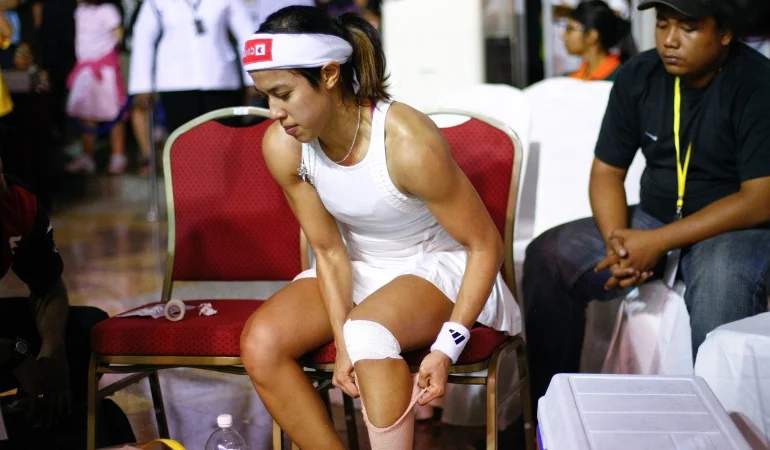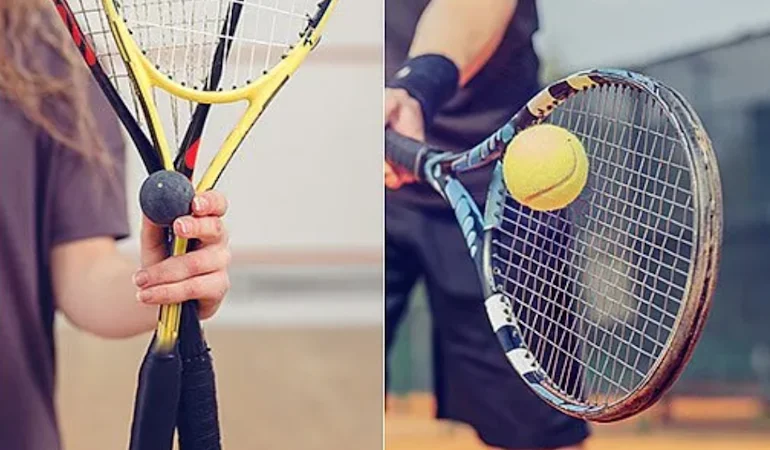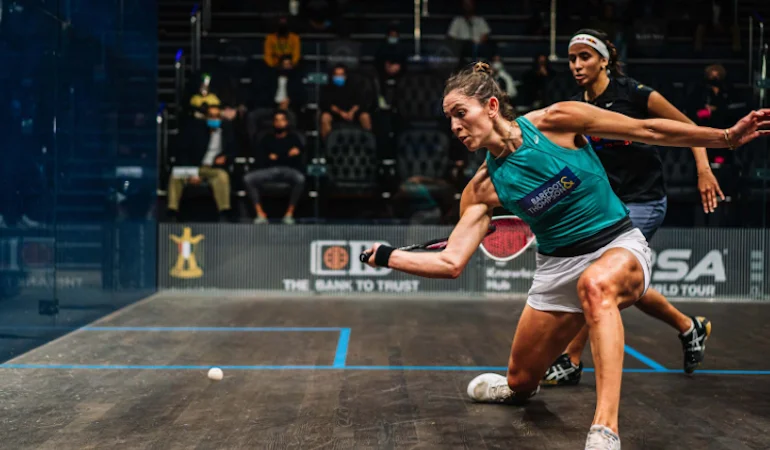Squash Injury Treatment and Recovery Best Practices

Here’s the low down on the most common squash injuries, treatments and recovery methods to get you back playing again.
Common Squash Injuries and Their Treatment
Muscle Strains and Sprains
Muscle strains and sprains are the most common squash injuries. These occur in the legs, mainly in the hamstrings, quadriceps, and calf muscles due to the sudden movements required during the game.
- Symptoms: Pain, swelling, bruising, limited range of motion.
- Treatment: Use the R.I.C.E method (Rest, Ice, Compression, Elevation) as soon as possible after the injury. Resting the muscle is key to prevent further damage. Ice to reduce swelling, then compression with a bandage and elevation to reduce inflammation.
Achilles Tendonitis
Achilles tendonitis is another common squash injury. It’s caused by repetitive stress and overuse of the Achilles tendon leading to inflammation and pain.
- Symptoms: Pain and stiffness in the Achilles tendon, especially in the morning or after activity.
- Treatment: Rest and avoid activities that aggravate the pain. Ice, anti-inflammatory medication and gentle stretching exercises can help reduce symptoms. Physical therapy may be needed for more severe cases.
Tennis Elbow (Lateral Epicondylitis)
Despite its name, tennis elbow is a common squash injury due to the repetitive gripping and wrist movements in the game.
- Symptoms: Pain and tenderness on the outside of the elbow which may extend into the forearm.
- Treatment: Rest the affected arm and avoid activities that cause pain. Ice the area and use a compression bandage to reduce swelling. Physical therapy exercises to strengthen the forearm muscles can help prevent future occurrences.
Ankle Sprains
Ankle sprains are common due to the quick changes of direction during a squash match. These occur when the ligaments in the ankle are overstretched or torn.
- Symptoms: Swelling, bruising, difficulty walking or putting weight on the affected ankle.
- Treatment: R.I.C.E as soon as possible. Once swelling subsides, rehabilitation exercises for strength and balance are key to full recovery and prevention of future occurrences.
Knee Injuries
Knee injuries such as ligament tears and patellar tendonitis can occur from the high impact and sudden stops in squash.
- Symptoms: Pain, swelling, instability, difficulty bending the knee.
- Treatment: Depending on the severity, treatment can range from rest and ice to physical therapy to surgery. Quadriceps and hamstring strengthening exercises can help stabilize the knee and prevent future injuries.
Table of Common Squash Injuries Treatment Options
| Injury | Symptoms | Immediate Treatment | Rehabilitation |
| Muscle Strain | Pain, swelling, bruising | R.I.C.E method | Physical therapy, strengthening |
| Tendonitis | Pain, stiffness, tenderness | Rest, ice, anti-inflammatory meds | Stretching, gradual return to activity |
| Tennis Elbow | Pain in the elbow and forearm | Rest, ice, compression bandage | Strengthening exercises, proper equipment |
| Ankle Sprain | Swelling, bruising, difficulty walking | R.I.C.E method | Ankle strengthening, balance exercises |
| Knee Injury | Pain, swelling, instability | R.I.C.E method, medical evaluation | Physical therapy, gradual return |
"Success is about consistency. If you train hard every day, the results will come." Heather McKay
Rehabilitation and Squash Injury Treatment Strategies
- Physical therapy is key to full recovery from squash injuries. A customized rehabilitation program can help restore strength, flexibility and range of motion.
- Once pain and swelling has decreased, incorporate strengthening exercises into your recovery routine. Focus on the muscles around the injured area to prevent re-injury.
- Don’t rush back into playing squash. Gradual reintroduction of physical activity allows your body to heal properly and prevent re-injury.
- Wearing the right shoes with good ankle support and using a racket with the correct grip size can reduce the risk of injury. Make sure your equipment is in good condition to avoid putting unnecessary strain on your body.
👉 Optimal Hydration Strategies For Squash Players
Preventing Future Injuries in Squash
Warm-Up and Cool-Down
A proper warm-up before playing squash is key to preparing your muscles and joints. Include dynamic stretches and light cardio in your warm-up. After playing, a cool-down with static stretches helps reduce muscle stiffness and aid recovery.
Listen to Your Body
Listen to any pain or discomfort during play. Ignoring these signs can lead to more serious injuries. If you’re in pain, take a break and see if you need medical attention.
Regular Check-Ups
Regular visits to a sports doctor or physio can help detect potential problems before they become injuries. They can give you advice on injury prevention and help you stay physically fit.
FAQs
1. How do I recover from a squash injury the fastest?
The fastest way is to R.I.C.E as soon as possible of squash injury treatment, seek medical advice, and follow a structured rehabilitation program that includes physical therapy, strengthening exercises and a gradual return to play.
2. Can I play squash with a minor injury?
Listen to your body. Playing with a minor injury can lead to more serious problems. Rest and proper treatment is key to not making the injury worse.
3. How do I prevent squash injuries?
Preventing squash injuries is about proper warm-up and cool-down, wearing the right shoes, using the right equipment and regular strength and flexibility training.
4. When should I see a doctor for a squash injury?
See a doctor if the pain is severe, the injury doesn’t improve with rest and basic treatment or if you have swelling, bruising and can’t move the affected area. Early medical attention can prevent long term damage.
Conclusion
Treatment and recovery from squash injuries is key to your performance and health on court. Follow these tips and you’ll recover smoothly and reduce the risk of future injuries.
Always put your health first, listen to your body and seek advice when needed. With the right care you’ll be back on court playing your best.

Frequently Asked Questions
Partners & Sponsors





